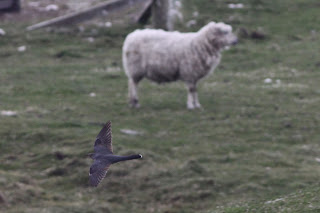24th May
Another mixed week, with westerly winds replaced by a northerly gale on Thursday, then a rather pleasant calm, sunny day on Friday. The westerlies slowed up migration, the northerlies delivered no decent seawatching and the calm weather saw a few new migrants, but with the promise of a pleasant weekend and easterly winds next week, things are looking rather good.
The best bird of the period was undoubtedly the
Red-necked Phalarope seen briefly in Mid Geo on 23rd by one lucky observer before heading west and not being relocated. Other good birds included female
Bluethroat (to 21st) with a new male on 24th at Kenaby,
Red-backed Shrikes daily (with 5 on 21st the peak count and 4 still today),
Icterine Warbler (in Field ditch on 24th),
Waxwing (until 23rd),
Lapland Bunting (daily until 24th) and
Long-eared Owl (21st-24th). Other promising signs of forthcoming migrants included an increase of
Lesser Whitethroats (to 8 on 24th), so I’m sure there’ll be more to come in the next few days.
More birds from recent days included a raptor-fest on 20th involving
Sparrowhawk,
Kestrel and
Merlin, a lingering pair of breeding-plumaged
Long-tailed Ducks in Furse then North Haven,
Redwing (23rd-24th),
Crossbill (23rd) and an arrival of 15
Snow Buntings on 23rd, with 12 still on 24th.
Wheatears increased to 136 on 24th, with many of them being Greenland race birds (fairly obvious in the field, but also confirmed by several trapped birds whose measurements confirmed the subspecific identification).
The seawatching highlight was a ‘blue’
Fulmar on 23rd; it’s fair to say that Fair Isle is not renowned for its seawatching, but still, to miss out on the influx of Long-tailed Skuas that everyone else seems to have enjoyed seems a bit harsh. Several hours effort were put in by several observers during the strong winds of 22nd-23rd, with nothing to show for it other than a few Arctic Terns heading north. The messages from various colleagues in conservation around the country keeping us updated on their sightings didn’t help, and the news that four Long-tails had flown over the Tingwall airstrip (where planes to Fair Isle leave Shetland from) were the final confirmation that we’re doomed never to cash in on spring skua passage (so at least I have played my part in the FIBO tradition of every Warden thinking there really must be skuas visible from somewhere on the island, before being disappointed).
However, it’s not like Fair Isle doesn’t get enough other birds, so I’m sure we’ll have plenty of compensation, hopefully starting with the promising conditions forecast for the next few days. One unexpected visitor that could potentially be heading our way is Iago Sparrow! For those of you who didn’t hear about it, a group of 11 of these Cape Verde endemics boarded the M/V Plancius off Raso, with 7 jumping ship at Madeira, but 2 pairs staying onboard until the ship reached the Netherlands. As far as I can tell, they seem fairly settled on the ship there, which is where it gets interesting… The next voyage of the M/V Plancius takes it to Spitsbergen via Aberdeen and Fair Isle, where it is due to arrive on 12th June. They probably won’t be tickable (although if they aren’t ‘deliberately’ fed from the Netherlands to British waters, does that mean they’d be countable, it’s like the ‘phases of play’ in the offside rule), but what if the rules change in the future? And surely they’d still be countable for your world list if you did see them? Anyway, it’s been a chance for a few interesting hypothetical conversations during recent stormy weather (and if they did stay aboard until they reached Fair Isle, I'm sure there'd be plenty more conversations about them). And before anyone accuses me of trying to drum up visitors for the Obs, although we've got a room free for the first week of June, we're fully booked for the 12th already!





.jpg)


2.jpg)
.jpg)


.2.jpg)






































